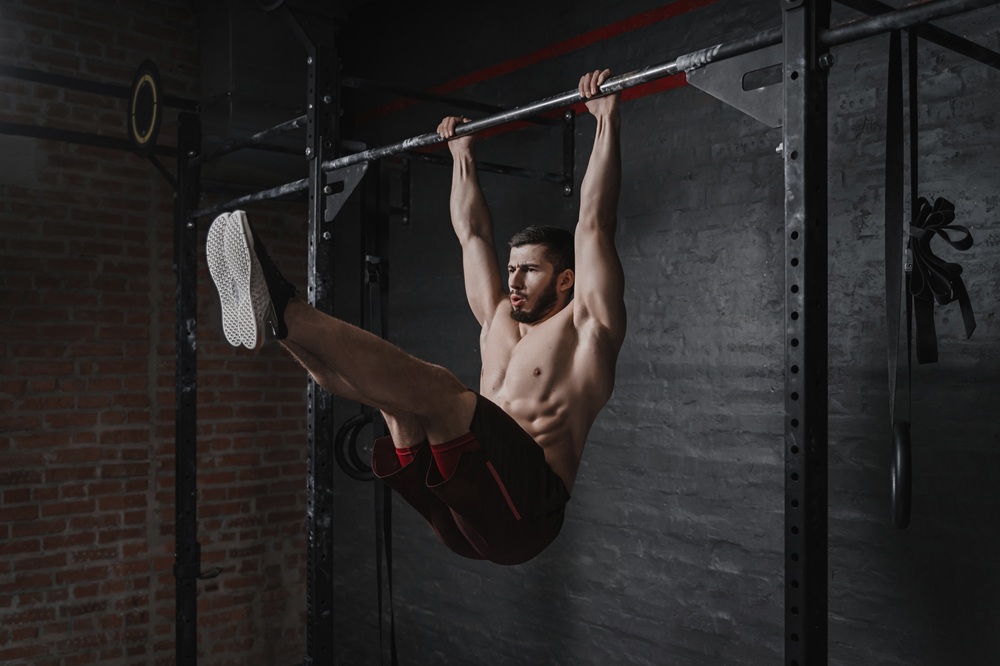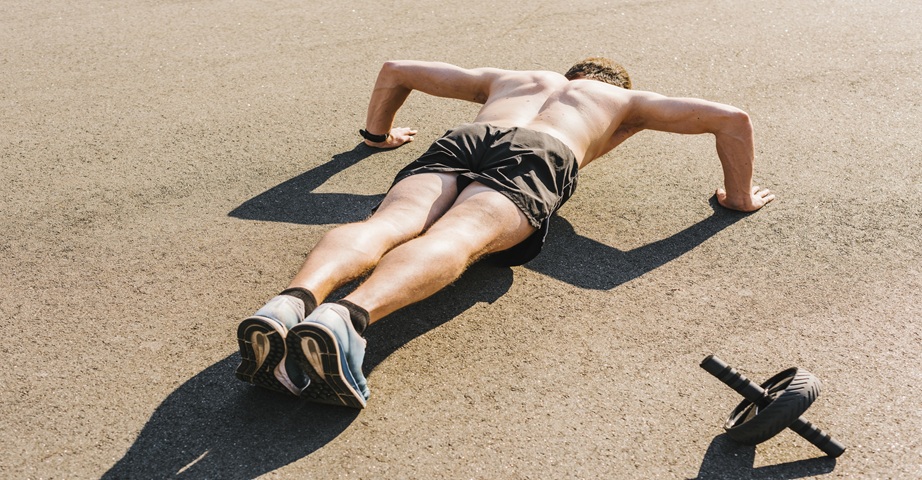Calisthenics training - what is it and how to get started?

Calisthenics is a type of physical activity that involves performing exercises using your own body weight. It offers a well-rounded approach to improving overall fitness, helping to boost endurance, stamina, and muscle strength while also supporting fat loss. This style of training is built around basic, familiar movements and is suitable for both beginners and more advanced athletes.
So, what exactly is calisthenics? What are its benefits, and how do you get started? What does a calisthenics training plan look like? And can you practice calisthenics at home?
Spis treści
- Calisthenics - what is it?
- The history of calisthenics
- Street workout and calisthenics - how do they differ?
- How to start calisthenics?
- Calisthenics for beginners - where to start?
- Basic calisthenics exercises for beginners
- Warm-up and stretching - why are they important?
- Calisthenics exercises - the most effective options
- Calisthenics training at home - how to do it?
- An example of calisthenics training at home
- Calisthenics - training plan
- Calisthenics - training plan for beginners
- Calisthenics training for intermediate athletes
- The effects of calisthenics training
- Calisthenics - how often should you exercise to see results?
- Summary - why is it worth trying calisthenics?
Calisthenics - what is it?
Calisthenics is a term that comes from ancient Greek, combining the words kállos (meaning beauty) and sthénos (meaning strength). It refers to a form of strength training that relies on using your own body weight, without the need for additional equipment or weights.
Calisthenics is often paired with stretching and includes exercises like push-ups, dips, and sit-ups. It’s a highly accessible form of training that can be done almost anywhere - at home, in the gym, or outdoors.
The history of calisthenics
Calisthenics is a form of physical exercise that was widely practiced by the ancient Greeks and Romans. The earliest references to calisthenics training come from Herodotus, who described the Spartans using this method to prepare for the Battle of Thermopylae.
There is also evidence that calisthenics was practiced by gladiators and later adopted in the training camps of Middle Eastern armies. During the Crusades, it was used to train squires aspiring to become knights. Over time, however, bodyweight exercises evolved into gymnastics, and calisthenics gradually faded into obscurity.
It wasn’t until the second decade of the 21st century that calisthenics regained popularity. Thanks to videos shared online, street workouts – largely based on calisthenics principles – began attracting more and more attention from fitness enthusiasts and people leading an active lifestyle.
Street workout and calisthenics - how do they differ?
The main difference between street workout and calisthenics is that street workout incorporates elements of urban infrastructure – such as benches, walls, and fences – into training, while calisthenics focuses purely on exercises that use your own body weight, without relying on any external structures.
Street workout often involves a playful, improvisational approach, whereas calisthenics training is typically more structured, aiming to master specific movements and gradually increase their intensity.
How to start calisthenics?
Calisthenics is a self-sufficient form of exercise that doesn’t require access to specialized equipment. You can train almost anywhere, using just your body and performing basic physical movements. All you really need is comfortable clothing, determination, and the motivation to take action.
So if you’re feeling ready, you can start calisthenics training today – right now, at this very moment. But to fully grasp the principles and benefits of exercising with only your body weight, be sure to read this article all the way to the end.

Calisthenics for beginners - where to start?
Calisthenics training includes a wide variety of exercises and modifications, allowing you to adapt your workout to your own needs and fitness level.
A great way to begin is by learning the correct technique for the “big six” exercises – foundational movements that are considered essential for building overall strength. These are especially popular among those just starting their journey with calisthenics.
Basic calisthenics exercises for beginners
The “big six” exercises include the following:
- Squats – these help build leg muscles, and thanks to their many variations, squats can be included in any calisthenics workout, with the difficulty adjusted to match your fitness level.
- Bridges – this exercise engages and strengthens the muscles of the spine and core.
- Dips – also known as parallel bar dips, these target the shoulder girdle muscles. They can be done using almost any stable surface that allows you to lift your own body weight.
- Push-ups – great for shaping the triceps and chest, the difficulty of push-ups can vary depending on factors like the width of your hand placement.
- Pull-ups – a compound movement that activates multiple muscle groups, especially the back, biceps, and rectus abdominis.
- Leg raises – these primarily target the abdominal muscles and, like squats, come in several variations to suit different fitness levels and abilities.
Warm-up and stretching - why are they important?
Before diving into calisthenics exercises, it’s essential to do a proper warm-up. Warming up prepares your entire body for intense activity, increases blood flow to your muscles, and reduces the risk of strains or other injuries.
Equally important is a thorough stretching routine after your workout. Post-exercise stretching helps relax tight muscles, promotes flexibility, and supports faster recovery. Skipping your warm-up or neglecting to stretch can leave you more prone to micro-injuries and can undermine the effectiveness of your training.
Calisthenics exercises - the most effective options
The most effective calisthenics exercises are the ones commonly known as the “big six,” mentioned earlier. These foundational movements are frequently used by calisthenics athletes to build overall strength and control. However, proper technique is crucial – performing even the simplest exercises incorrectly can lead to injuries or reinforce poor movement habits over time.
Push-ups
To perform a proper push-up, place your hands flat on the ground with your fingers pointing forward. Your hands should be slightly wider than shoulder-width apart and aligned directly under your shoulders. Straighten your body, resting on your toes, and keep your back flat and core engaged.
Bend your arms outward and lower your body slowly, without letting it touch the ground. Then, push through your palms to lift yourself back up to the starting position in a controlled motion.
People who have trouble performing standard push-ups can start with a modified version – knee-supported push-ups – resting on the knees instead of the toes. This variation helps build strength while maintaining proper form.
Squats
To perform squats correctly, begin by placing your feet shoulder-width apart or slightly wider. Keep your back straight, engage your core, and bend your knees until your thighs are parallel to the ground, forming a 90-degree angle with your lower legs. Stretching your arms out in front of you can help with balance and allow you to focus your gaze forward.
Pull-ups
Pull-ups can be challenging for beginners, but using the small steps method can make progress more manageable and help you build the necessary strength and technique.
Start by simply hanging from the bar to improve grip strength and get comfortable with the movement. Once you're ready, work on pulling yourself up until your chin is above the bar. Then, slowly lower your body back down, fully extending your arms before repeating the motion.
Leg Lifts
To perform leg lifts correctly, lie flat on your back with your arms resting alongside your body. Keep your legs together and point your toes. Engage your abdominal and glute muscles, then lift your straightened legs a few centimeters off the ground. Hold this position for a few seconds, maintaining tension in your core, and then slowly lower your legs back to the starting position.
Dips
Dips on parallel bars can be done outdoors using elements of urban infrastructure, or at home with stable supports like chairs.
To perform the exercise properly, grip the bars with your palms facing inward. Bend your legs so your feet are off the ground. Straighten your arms to lift your body, then slowly lower yourself by bending your elbows – keeping control throughout the movement – without letting your feet touch the floor.
Bridge
The bridge is a classic exercise often taught in school PE classes. To perform it, lie on your back with your knees bent. Place your hands on either side of your head, fingers pointing toward your shoulders. Then, lift your hips, buttocks, and shoulders off the ground. Finally, lift your head and straighten your arms to complete the movement.
Calisthenics training at home - how to do it?
Calisthenics exercises can easily be done at home and are popular among those who prefer working out in their own space. Since calisthenics doesn’t require special equipment or much room, you can practice almost anywhere in your home.
If you choose to train at home, it’s helpful to have an exercise mat and a pull-up bar. Resistance bands can also be useful for more advanced athletes. However, keep in mind that you can still get a great workout using just your body weight and common household items like chairs or bed frames.
An example of calisthenics training at home
Wondering what a beginner’s calisthenics workout might look like at home? First, find a comfortable space in your home and take a moment to relax and prepare your body. Start with a proper warm-up to get your muscles ready for exercise, then move on to the workout itself.
Here’s a simple routine you can try:
- Forward lunges × 5
- Classic push-ups × 4
- Leg lifts × 8
- Plank – hold for 30 seconds × 2
- Bridge × 4
- Dips × 5
After completing your workout, be sure to stretch. Stretching helps relax tight muscles and lowers the risk of injury.
Calisthenics - training plan
To achieve the best results, it’s essential to carefully plan the type and order of exercises, tailoring your routine to fit your individual needs and fitness level. Before starting, it’s a good idea to create a personalized training plan. If you have any doubts about which exercises to choose or how to structure your workouts, consulting an experienced personal trainer who specializes in calisthenics can be very helpful.
Calisthenics - training plan for beginners
If you’re new to bodyweight strength training, start with basic calisthenics exercises and adjust the number of repetitions and sets according to your abilities. Here’s an example of a beginner’s training plan:
- 10-minute full-body warm-up
Main workout – 3 sets of the following exercises:
- Push-ups × 4
- Leg raises × 6
- Jump squats × 8
- Bridge × 4
- Pull-ups × 4
- 10-minute stretching session
Calisthenics training for intermediate athletes
One of the great benefits of bodyweight training is its flexibility — exercises can be modified and varied to match your skill level. When basic calisthenics no longer challenge you, it’s a good idea to diversify your routine by:
- using additional equipment like resistance bands
- incorporating everyday objects such as sofas, beds, or chairs to add new challenges for your muscles
- taking advantage of urban infrastructure and architectural elements
- combining basic movements into longer sequences
- increasing difficulty by modifying familiar exercises — for example, doing single-leg squats or changing your grip during pull-ups
So, what might a calisthenics workout for intermediate athletes look like?
- 10-minute full-body warm-up
Main workout – 5 sets of the following exercises:
- Single-leg squats × 5 per leg
- Diamond push-ups × 8
- Dips × 8
- Plank with hand walkouts – hold for 30 seconds × 3
- Hanging leg raises on the bar × 8
- 10-minute stretching session

The effects of calisthenics training
Calisthenics, as a form of strength training, can help increase muscle mass while also improving reflexes, flexibility, and psychomotor skills. Since it relies on your body weight rather than additional weights, calisthenics places less strain on your joints, which helps prevent injuries and lowers the risk of trauma.
Regular calisthenics training enhances muscle endurance and strength. Additionally, bodyweight exercises promote better mobility and flexibility, improve motor coordination, overall fitness, and physical performance. Calisthenics can also aid in reducing body fat, supporting weight loss, and sculpting the physique.
Beyond physical benefits, calisthenics positively impacts both appearance and well-being. As a form of active rest, it can reduce the risk of lifestyle-related diseases and boost self-confidence by strengthening your sense of control over your body and health.
Calisthenics - how often should you exercise to see results?
It is generally recommended to practice calisthenics 3 to 4 times per week, making sure to include rest days between sessions. These breaks allow your body to recover, helping to prevent muscle and joint overload as well as reducing the risk of micro-injuries and other strains.
Research and experience show that noticeable changes in body shape typically appear after about four weeks of consistent calisthenics training. Meanwhile, improvements in well-being can often be felt right after the very first workout, thanks to the release of endorphins triggered by physical activity.
Summary - why is it worth trying calisthenics?
Calisthenics is an enjoyable and effective form of exercise that strengthens muscles, including those in the chest, back, and shoulder girdle. It can also help increase muscle mass and improve overall muscle strength.
Since it doesn’t require special equipment or specific weather conditions, calisthenics is accessible and increasingly popular among both beginners and advanced athletes passionate about strength training. With a well-designed training plan and consistent progress tracking, calisthenics can help you reach your fitness goals and improve your physical condition.

